Deborah Harris: In Her Own Words
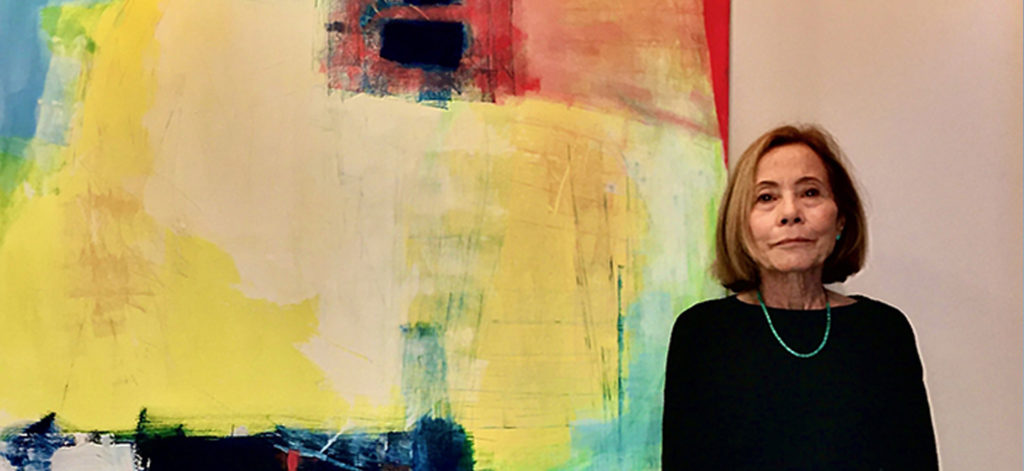
Oct, 25, 2022
ArtistsCommunityPhxArtist Spotlight
Deborah Harris: In Her Own Words
“My painting practice offers me an embodied way of engaging—and struggling against—the reality of the world, with all its inequities and dualities alongside the captivating beauty and the perseverance of the human spirit.”
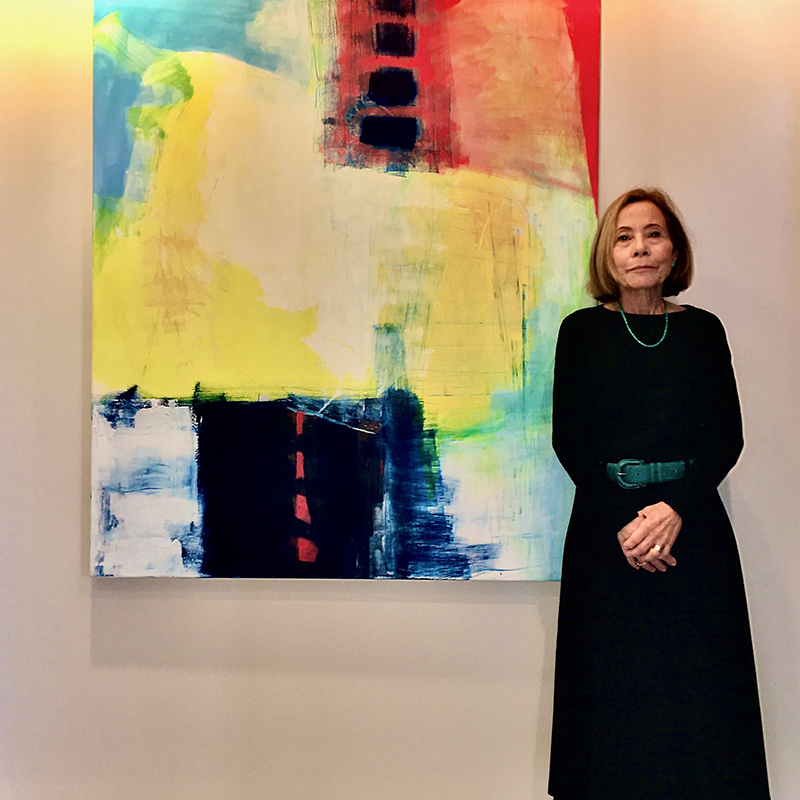
Deborah Harris, Portrait. Courtesy of the artist.
PhxArt: Tell us about who you are and where you’re from. What was your first inspiration?
Deborah Harris: I was born in Oneonta, New York, in 1949, and I have been drawing since I can remember. I had my first exposure to painting daily at age 9. My family had moved to Tucson, where I attended a public school nearby. When my teacher realized that I could read and write above the fourth grade level, I had the opportunity, along with a couple of other students, to be rewarded with time quietly spent in the back of the classroom. There was a two-sided wooden easel, so two of us could paint as much as we wanted at the same time, with an assortment of tempera paints, brushes, and paper.
Thereafter, through each level of my education into college, I always enrolled, or snuck, into art classes. I learned some basics—how to stretch canvases, draw, use materials, etc. From 1973 to 1976, I lived in Mexico, where I painted all day long while my husband attended medical school. It was then that I really began the process of becoming an autodidact. I studied The Artist’s Handbook by Ralph Mayer and read books on multiple artists, absorbing their histories and paintings. I converted one room into my studio and did the usual things; made still life paintings of Cezanne-like fruit arrangements, figurative work based upon photos, and many sketches. Mostly the thing I learned during that period was the value of sketchbooks. I couldn’t afford to make canvases on the scale I do now, so I used to plan my work very carefully. I didn’t have the freedom to start with a blank canvas, so I did multiple sketches for each finished piece. I didn’t want to make paintings that I had to erase—the paint was too precious. I would say I began to consider myself a working artist in Guadalajara, and subsequently, upon return to Tucson when I began to split my time between a part-time job and painting.
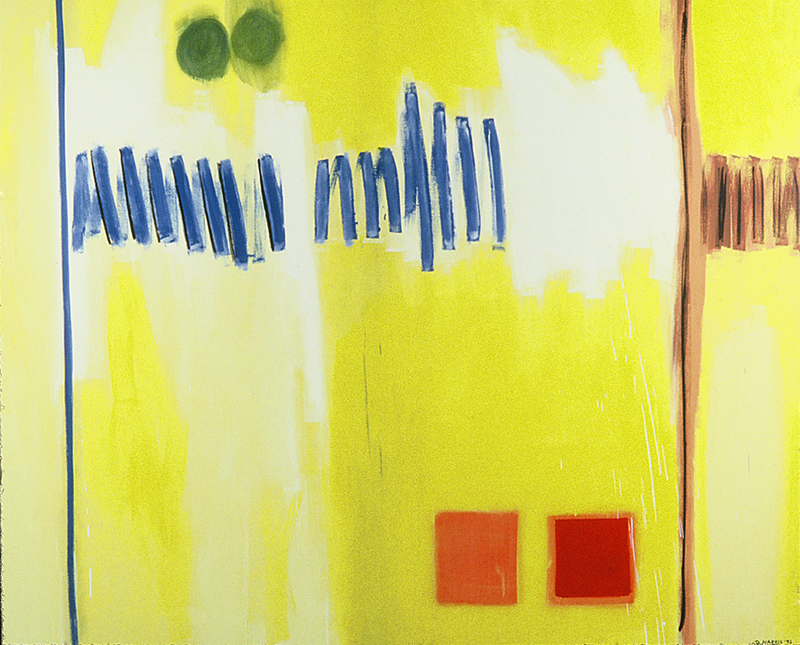
Deborah Harris, A Primary Defense, 1992. Oil on canvas. Courtesy of the artist, Photo: John Ormand.
PhxArt: How has your career evolved since then?
DH: When I moved to Albuquerque in 1978, I fell in love with the high desert “white” light and landscapes. I was a member of a Downtown Artist’s Collective and participated in several group shows. I had my son in 1980, so I had to work on a tight schedule of nap time, but I took a page out of Barbara Hepworth’s book. I was determined to be both a serious artist and a mother. I didn’t have five children during a war in a rural art commune—so if she could do it, I knew I could swing it, too. I had a considerable body of work when I had the fortune of meeting Raymond Jonson, who to my delight, both understood and loved my paintings. He put me on the docket for my first solo show in the Raymond Jonson Gallery at the University of New Mexico. Some pieces sold, and thereafter, I became a member of Arlene Wackerbarth’s Performance Gallery. I was surrounded by artists who were older than me that I could learn from and whose work I respected, like Jaune Quick-to-See Smith. I was a guest lecturer at the University of New Mexico’s Philosophy Department’s Summer Seminars in 1981 and 1982 at the D.H. Lawrence Ranch in Taos.
After I moved to Phoenix in 1982, I showcased at the Ashland Folk Collective in a downtown gallery, and then was invited to be a member of the Ianuzzi Gallery. I also had a six-month exhibit at the Peoria Public Library. In 1991, I won a juried competition judged by art historian and critic Arlene Raven at the Phoenix Gallery in New York City., and became a member of the gallery. A few years later, I was invited by the curator of the James A. Michener Art Museum in Doylestown, Pennsylvania, to participate along with three other artists in the exhibition SURFACE, SYMBOL, PSYCHE: Contemporary Abstract Painting, from March 22-June 8, 1997. I have been a member of “The Breakfast Club,” invited by Beth Ames Swartz, since 2004 and have been in several group shows over the years. I have also participated in Phoenix Art Museum’s ‘Contemporary Art Forum’ Auction and events.
PhxArt: What motivates you to continue creating?
DH: I would say that I am motivated by the need to communicate visually what cannot be communicated any other way. I realize that I have had to master the language of paint to communicate what is most important to me, and that this mastery has developed and evolved alongside my priorities over the course of my lifetime. In retrospect, as I moved through the experiences of falling in love, raising children, burying my parents, maintaining a marriage, and surviving cancer, my paintings moved alongside me. They serve as a record and testament to my life, from my perspective, on my terms, in the way in which I want my story told, which is a radical endeavor in itself. It is such a wonderful gift, and it brings me a lot of joy.

Deborah Harris, End of Innocence, 1998. Oil on canvas. Courtesy of the artist, Photo: John Ormand.
PhxArt: What are the media that you prefer to work in?
DH: I almost exclusively work in oil paint and on large canvases, typically 60×72 inches. I started making these larger paintings while in Tucson because I had a bigger studio and more resources. I also found that I worked on that scale much better.
When I try to explain to people why I make work at this scale, I tell them the scale is really in reference to my embodied experience. In my world, everything is bigger than I am. So, it was perfectly normal for me to be smaller than my paintings. Additionally, after working on paper and on a budget, all that blank space gave me a freedom I hadn’t had before, and when the paintings were finished, I felt a sense of power! Because, you have to remember, the odds were not in favor of women artists at the time, as the Guerilla Girls made plain; you were more likely to get into a museum as the nude subject than as an artist. I didn’t want anyone to know that I was a woman; it was a disadvantage for competitions. I wanted my work to speak for itself, to take up space, and to announce itself unequivocally.
I also find that oil paint, unlike watercolor or acrylic, is much more malleable, and initially much less permanent and more adaptive to a variety of mediums. Additionally, I can make vibrant palettes in oil. Gerhard Richter’s technique for applying layers of paint made a categorical difference in my application, to scraping layers on and off, and pushing the theme of surface even further.
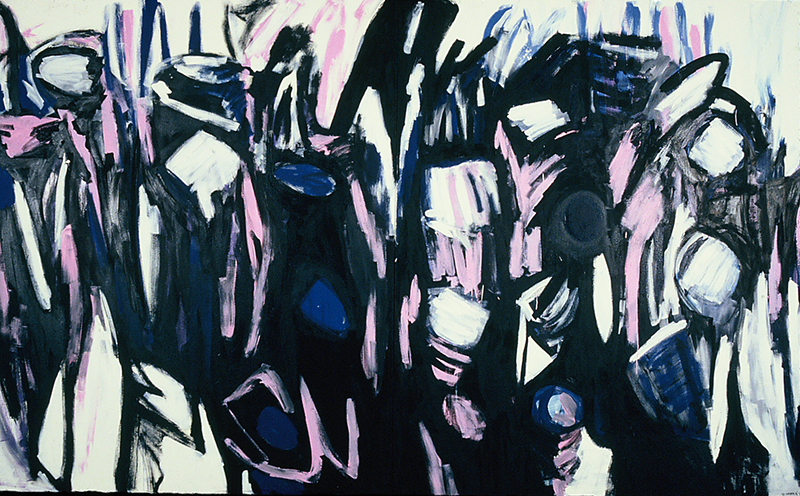
Deborah Harris, Baile de Mascaras, 1988. Oil on canvas. Courtesy of the artist, Photo: John Ormand.
PhxArt: What are the topics and subjects you most focus on, and how did you become interested in them?
DH: After college, I worked in the Model Cities Program—a federally funded program to encourage civic involvement with city and state governments and help improve living conditions and public works, with a subtext of achieving cooperation among multiple minority groups. Civic engagement and minority representation remains important to me. Political themes often make their way into my work in subtle ways because my work is rarely figurative. My painting practice offers me an embodied way of engaging—and struggling against—the reality of the world, with all its inequities and dualities alongside the captivating beauty and the perseverance of the human spirit. All of it makes its way into my work.
Early on in my art career, I was enamored with the Russian Constructivists and so my paintings from that time were hard-edged—flat colors within geometric forms. I now recognize that I was painting both abstract real-world forms as well as those that started to emerge from my internal landscapes. I was developing my own “language” through form, color, and composition. In many ways, the subject of my paintings is the paint itself and my experience of interacting with it, to manipulate it in the intended way. In my Peoria dream studio, I began to explore new approaches to both the surface and forms. It took me about five years to release myself from my self-imposed constructivist constraints. Eventually, I created a lot of work that referenced Indigenous art and the profound light, a space, and form of the landscape of the Arizona desert.
I would say that my art is often a reaction to global politics and an attempt to process senseless invasions and pointless wars. I realize now that my approach to the canvas could be transformed in a single instance of artistic recognition—a nod from another as though I was being given permission or approval to be more daring, to become more of the artist I wanted to become. This was the case after I encountered the work of Anselm Keifer, whose work deals with the heavy taboo cultural history of post WWII Germany. The scale of the work was shocking, and the content was brutal, and it made a big impression on me—not only the emotional and visual aspects, but the methods of construction. I decided if I wanted to, I could do bigger paintings—and I could extend this storytelling aspect to my own work. After seeing his work, I started one of my largest paintings, the Baile de Mascaras, alternatively called family portrait, which is massive and quite severe. Everybody looks a little bit like they might kill you. I think this served as a watershed moment for how personal and narrative I would allow my paintings to become.
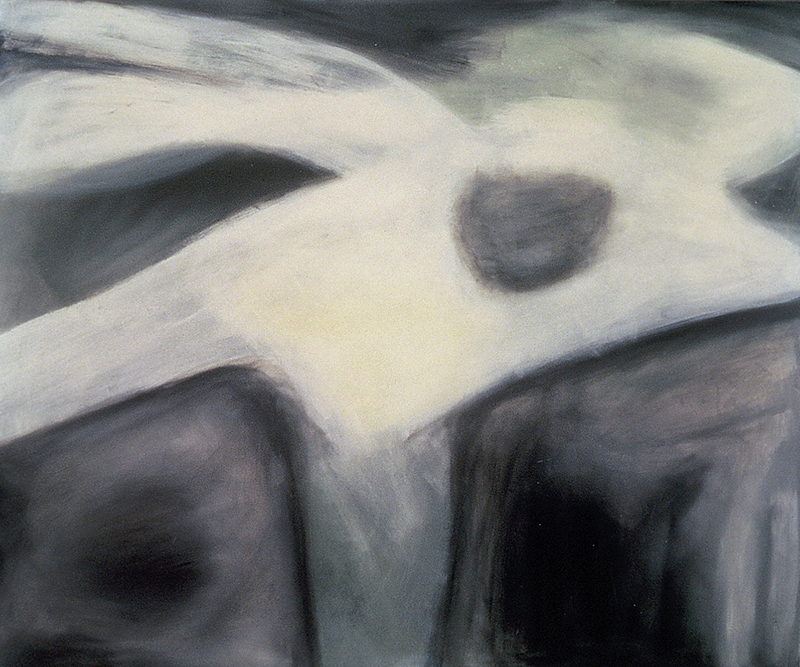
Deborah Harris, Ghost Girl, 1993. Acrylic. Courtesy of the artist, Photo: John Ormand.
PhxArt: Who are your greatest artistic influences?
DH: Most of the time when I am in my studio, I am listening to music while I paint. Some of my paintings become influenced by what I’m listening to. Lighten Up While You Still Can Gustave is my visual reaction to Gustav Mahler’s 9th Symphony, for example. I also listen to a lot of West African and Middle Eastern music, including Habib Koité and Ali Farka Touré. I also love to listen to the musical compositions of Keith Jarrett and The National.
I am inspired by the work of Clemente, Modigliani, Joan Miró, David Hockney, Arshile Gorky, Piet Mondrian, Édouard Manet, Pablo Picasso, Robert Motherwell, Helen Frankenthaler, Jasper Johns, Francis Bacon, Gustav Klimt, the Bauhaus painters, Henri Matisse, Marc Chagall, Richard Diebenkorn, Susan Rothenberg, Max Beckman, Christo Vladimirov Javacheff, Berthe Morisot, and Mary Cassatt. More directly, my work has been influenced by the artists with whom I shared space or values, such as The New Mexico Taos and Santa Fe transcendentalists, Deborah Remington, Barbara Hepworth, Mark Rothko, Joan Mitchell, and the cumulative effect of viewing multiple exhibitions at the Heard Museum throughout the years.
PhxArt: What is some advice you’d give to aspiring artists just beginning to build their professional practice?
DH: You cannot intellectualize yourself into being an artist. The only way you can be the artist you wish to be is to continue to make your art, no matter what. Do not be discouraged by the reactions or critiques you may get. Remember you are the most important judge of your work. Mainly, do not become discouraged by the lack of notice or applause. Give yourself time and space to make progress in your work. Take every opportunity available to you to show your work in public, and to see all the great art you can in person.
Also—and I learned this the hard way—for an artist, even bad press is valuable press. I’ve been panned on the same page as some fantastic artists including Manuel Neri, and subsequently defended by lauded art critics. It turns out one of the best ways to get people in the door to your opening is to get a terrible review in the newspaper.
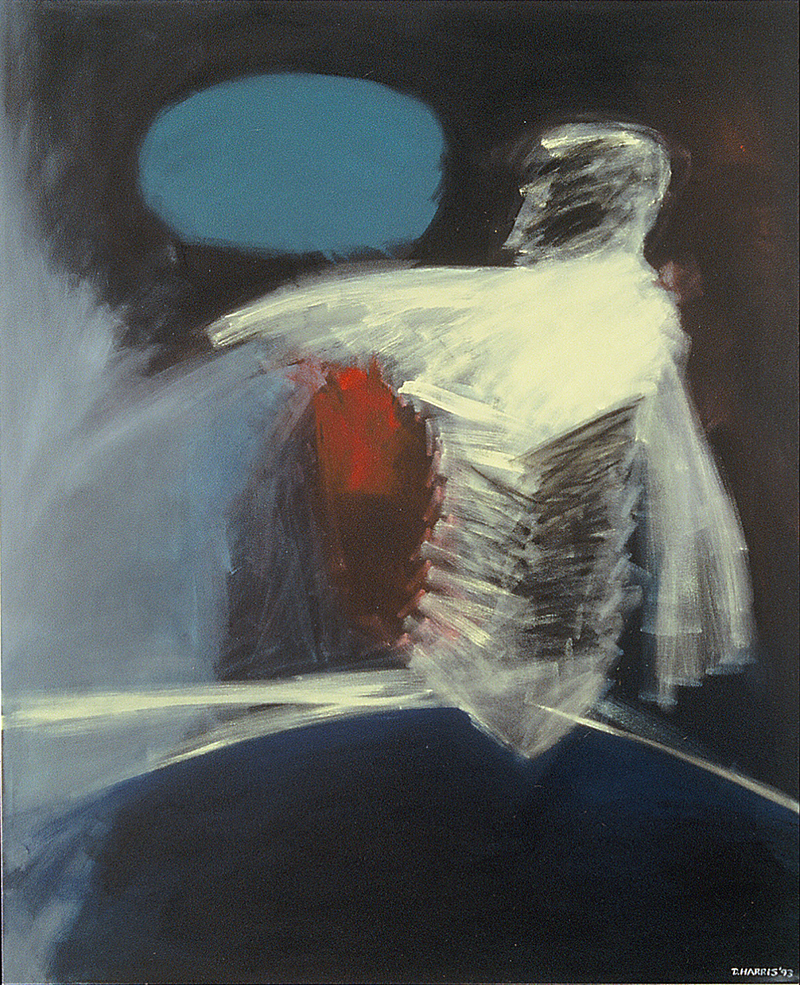
Deborah Harris, To Another Universe, 1993. Oil on canvas. Courtesy of the artist, Photo: John Ormand.
PhxArt: What can our community expect to see next from you?
DH: I have finally put together a wonderful website, and I am always happy to find opportunities for exposure in galleries and museums. Primarily, I sell my work directly from my studio, but I am also always on the lookout for places to exhibit. As for sparking something new, I am working on my once every 25 years self-portrait… it might take a while.
SEE MORE
To see more artwork by Deborah Harris, visit www.deborahharrisart.com or follow her on Instagram @deborahharrisart.
#CreativeQuarantine
PhxArt: We’re curious how creatives navigated the time of coronavirus. Deborah Harris shares what gave her life during the pandemic.
DH: I have very close friends and family I kept in contact with. We would FaceTime and do Zoom dinner parties. I really maximized virtual pilates. I finally got to see my kids and grandchild in person for proper hugs this past summer. COVID was a very strange experience. I am a cancer survivor and am immunocompromised, so I was almost completely isolated from March 2020 until February 2021 when immunizations started, and keep up with the booster shots, which is a relief, but in truth, when I think about the issues facing our world, along with the added mayhem of the pandemic, it has all been so psychologically numbing. I do not think I have fully recovered from some aspects of the isolation and constant worry about our planet, and the senseless violence in our world.
But I don’t shy away from it. I read voraciously. I read The New York Times cover to cover daily, The New Yorker, and the New Republic. Before the pandemic, I frequented the library to check out as many books and foreign films as they would let me. I love foreign films! I am deeply affected by the viciously cyclical racial violence. And I’m confused by the anti-science movement in America, but I find solace in remaining awake to it. I also make a point to economically support institutions that provide value and reprieve to those who need it most because it’s very hard to make a political impact without resources.
Categories
What can we help you find?
Need further assistance?
Please call Visitor Services at 602.257.1880 or email